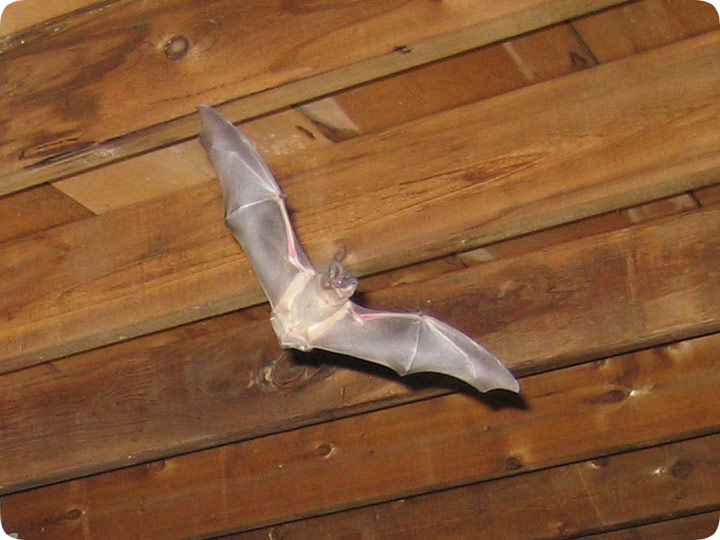-
info@aaanimalcontrol.com
Call us for help in your town
Humane Wildlife Education
How Do I Get Bats Out of an Attic?

First of all, it's not just your home and health at stake - there's also the welfare of the bats to consider, and I've seen too many botched home remedy attempts that have failed to solve the problem while succeeding at harming a few bats that I'd prefer to tell as many people as possible to trust the experts when it comes to bat removal.
To get bats out of an attic, the principle can be pretty simple - just install one-way exclusion devices over the entry points and seal off all secondary points of entry, and allow the bats to leave on their own, but not return. However, as usual, this is easier said than done, and requires experience, knowledge of bat behavior, architecture, exactly how bats fly, and several other factors that a book could explain, but only hands-on experience can really teach.
So if you've got bats in the attic, such as in the above photo from last night's work, give me or a local professional a call. This has been a public service announcement, sponsored by the wallets of Bat Removal Companies of America Associated. No seriously - I often do bat work at well under my normal wildlife removal rates, because I don't want to see these animals hurt.
Do it yourself: Visit my How To Get Rid of Bats page for tips and advice.
Get professional help: Visit my Nationwide Pro Directory of wildlife removal experts.
For more wildlife stories, click my Wildlife Blog or click my below banner to hire a local trapper.

The attic is one of the spaces bats are bound to occupy when they infest a property. The critters like warm and high spaces and hate people being in their space. The attic is one of the best spaces where all the criteria of a home for bats are met. When bats occupy an attic, they can easily multiply, create a large colony, and cause significant damage from their activity. The feces (guano) they leave behind, for example, can cause significant damage to the structure of properties.
Are there bats in my attic?
You would be able to tell whether bats have occupied your attic by the factors such as the time noise comes from the attic and physical sightings. Bats are nocturnal animals and are most active at dusk. If the noise from the attic is loudest at dusk, then the infestation is most likely by bats. You can also watch out for the bats as they leave for the night. Physical sightings will both confirm the presence of the bats and identify the entry point.
Humane methods of removing bats
Bats are a protected species, with laws guiding their removal differing according to the location. Humane methods such as the use of one-way exclusion devices are acceptable for the removal of these creatures.
It is also important to find out whether there are baby bats in your attic. If there are baby bats in the attic and you removed the adult bats unknowingly, the helpless pups will die and you will have to deal with the carcasses.
After confirming the entry points of the bats and whether there are babies, you can then begin the removal properly.
Start by closing all the secondary holes while leaving the primary hole open. The primary hole is where you noticed the critters flying out from at dusk. The secondary holes are the other holes you found when inspecting the attic. You should close the holes at night after the bats have left, in line with their nocturnal habits. The initial inspection should also be scheduled for when the critters are not in the attic and proper protective coverings should be worn. After the secondary holes have been sealed, install an exclusion funnel on the primary hole. With the exclusion funnel on the primary hole, you create an exit point and remove all points of entry.
After you are sure that all the bats in your attic are gone for good, you can then remove the exclusion funnel and seal the primary hole. With the use of exclusion funnels, you get to remove the bats in your attic without directly interacting with them.
Another aspect of getting rid of bats out of the attic is to reclaim it completely by removing the feces and disinfecting it. For the cleaning and disinfection step, wear protective materials to avoid exposure to disease-causing agents spread by bat droppings.
Bats cause a lot of noise, can destroy the structure of properties, and cause diseases. You should work towards getting the critters out of your attic as soon as you notice their presence.




















